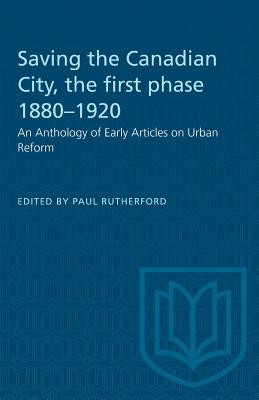
- We will send in 10–14 business days.
- Publisher: University of Toronto Press
- ISBN-10: 0802062474
- ISBN-13: 9780802062475
- Format: 14 x 21.6 x 2.2 cm, softcover
- Language: English
- SAVE -10% with code: EXTRA
Saving the Canadian City, the first phase 1880-1920 (e-book) (used book) | bookbook.eu
Reviews
Description
The rapid, chaotic growth of Canada's cities in the late nineteenth century bred a host of social and economic problems that were most evident in Montreal, Toronto, Winnipeg, and Vancouver. The daily press soon made its readers aware of the perils of overcrowding, the appearance of slums and ghettoes, the threat of disease and the evils of vice, the greed of utility corporations, and the corruption of municipal governments. The recognition of this urban crisis led some middle-class Canadians to embark on a reform crusade hoping to create and ordered social environment.
The urban reformers were very much the products of their age and class -- aggressively optimistic, self-righteous, materialistic, humanitarian but self-interested, romantic and pragmatic. They endeavoured to restrict the power and autonomy of utility corporations; to establish uniform standards of health, housing, sanitation, and welfare; to compel the submission of lower-class and immigrant residents to bourgeois norms of behaviour; and to rationalize and beautify the urban topography. Most important, they turned to the bureaucratic state to ensure the permanence of their reforms. Ironically, their ideas and techniques became in later years the orthodoxy of civic government, against which the new generation of reformers has begun to struggle.
The twenty-nine selections in this book are representative of the variety of concerns evident in reform circles when the first movement was in full flower, from the turn of the century to the end of the First World War. They have been organized around four general themes: the debate over municipal control of public utilities; the efforts to make the city healthy, moral, and equitable; the desire for a planned urban environment; and the changing character of municipal reform schemes.
EXTRA 10 % discount with code: EXTRA
The promotion ends in 19d.18:30:08
The discount code is valid when purchasing from 10 €. Discounts do not stack.
- Publisher: University of Toronto Press
- ISBN-10: 0802062474
- ISBN-13: 9780802062475
- Format: 14 x 21.6 x 2.2 cm, softcover
- Language: English English
The rapid, chaotic growth of Canada's cities in the late nineteenth century bred a host of social and economic problems that were most evident in Montreal, Toronto, Winnipeg, and Vancouver. The daily press soon made its readers aware of the perils of overcrowding, the appearance of slums and ghettoes, the threat of disease and the evils of vice, the greed of utility corporations, and the corruption of municipal governments. The recognition of this urban crisis led some middle-class Canadians to embark on a reform crusade hoping to create and ordered social environment.
The urban reformers were very much the products of their age and class -- aggressively optimistic, self-righteous, materialistic, humanitarian but self-interested, romantic and pragmatic. They endeavoured to restrict the power and autonomy of utility corporations; to establish uniform standards of health, housing, sanitation, and welfare; to compel the submission of lower-class and immigrant residents to bourgeois norms of behaviour; and to rationalize and beautify the urban topography. Most important, they turned to the bureaucratic state to ensure the permanence of their reforms. Ironically, their ideas and techniques became in later years the orthodoxy of civic government, against which the new generation of reformers has begun to struggle.
The twenty-nine selections in this book are representative of the variety of concerns evident in reform circles when the first movement was in full flower, from the turn of the century to the end of the First World War. They have been organized around four general themes: the debate over municipal control of public utilities; the efforts to make the city healthy, moral, and equitable; the desire for a planned urban environment; and the changing character of municipal reform schemes.


Reviews